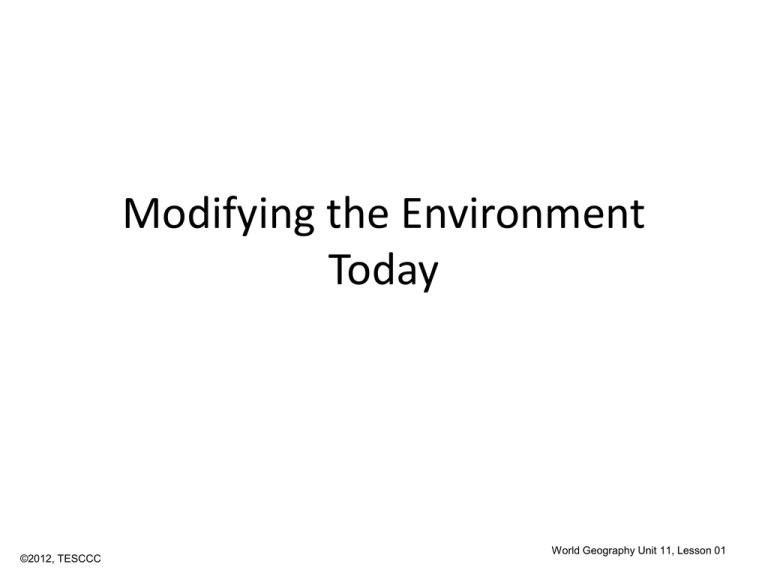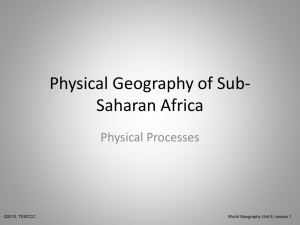Modifying the Environment Today
advertisement

Modifying the Environment Today ©2012, TESCCC World Geography Unit 11, Lesson 01 Natural Disasters and Preparedness ©2012, TESCCC Earthquake Drill in Japan ©2012, TESCCC Natural Disaster Preparedness Drill ©2012, TESCCC Balancing on several tectonic plates, Japan is one of the most earthquake-prone countries in the world, with more than 130,000 quakes logged in 2005. Evan Osnos wrote in The New Yorker, “To geologists, earthquakes are a constant in the planet’s eternal becoming. To the Japanese, they are simply a constant. In a given year, there can be hundreds, usually barely discernible micro-events. They rattle the pictures on the wall, the china on the table, but they rarely stop the conversation." Even so according to Yomiuri Shimbun survey, 78 percent of Japanese worry about a major earthquake. [Source: Evan Osnos, The New Yorker, March 28, 2011] Living with earthquakes in Japan, Facts and Details.com ©2012, TESCCC Effects of natural disasters (preparedness) • Railway systems automatically shut down during an earthquake • Strict building codes are put in place for new construction • School children participate in preparedness drills • Earthquake and tsunami warning systems on television ©2012, TESCCC Detection Monitoring Systems Earthquake warning system uses broadcasting stations, mobile phones, and television to warn people. J-Alert uses satellites and media to alert people through a loud speaker ©2012, TESCCC Average annual population affected and killed by natural disasters, world regions, 2001-2010 ©2012, TESCCC Three Gorges Dam ©2012, TESCCC 3 Gorges Dam Statistics • Type of Dam: Gravity • Materials: Concrete • Location: The Three Gorges of the Yangtze River, longest river in Asia, 3,900 miles long • Completed: 2006; fully operational 2011 • Cost: $25 billion, estimates vary • Benefits: decrease flooding, improved shipping, hydroelectric power • Impact: costs may outweigh its benefits, large expanse of land was cleared to create a reservoir, 1.5 million people displaced, cultural sites underwater, endangering animal habitat • Alternative: building smaller dams and using newer technology to produce energy ©2012, TESCCC ©2012, TESCCC ©2012, TESCCC …., a key lesson of the Three Gorges Project is that dams can have serious geological impacts. The fluctuating water levels of the reservoir on the Yangtze have destabilized hundreds of miles of slopes and triggered massive landslides. Most of the projects discussed under the new Five-Year Plan would be built in China’s mountainous Southwestern region, which is seismically active. The devastating earthquake of 2008 in Sichuan Province, which damaged hundreds of dams may have been triggered by a reservoir, further illustrated the risk of building hydropower projects on fault lines. ©2012, TESCCC Landslide on the Three Gorges reservoir Statement from the Embassy of the People’s Republic of China in the U.S. About 1 million people will be relocated owing to the construction of the project. The government has attached great importance to the issue and decided to appropriate large sums of money for the resettlement program. The guiding principle of the program is that the life of the relocatees can only be improved. For this purpose, the government has adopted developmentoriented resettlement, in other words, to combine resettlement with local economic development. The relocatees find higher-paying jobs in the newly set up businesses, which are usually located within the same country or city. Therefore, they feel quite at home and enjoy a better living in their new homes. ©2012, TESCCC Land Reclamation ©2012, TESCCC Taken from Article: South Korea Undergoes Controversial Wetlands Reclamation Project Environmentalists say South Korea could be heading towards a major ecological blunder as it begins a multibillion dollar land reclamation project about seven times the size of Manhattan that the country believes will lift its economy.South Korea’s Saemangeum land reclamation project uses a 20.5 mile sea dyke to reclaim an area of 155 sq miles, turning coastal tidelands that are key feeding areas for globally threatened birds into land for factories, golf courses and water treatment plants.Park Hyoungbae, an official with the Saemangeum development authority project, said the reclamation was not about protecting the environment, but about economic development. ©2012, TESCCC Land reclamation project underway in Bingzhou Peninsula in China ©2012, TESCCC Bullet Trains ©2012, TESCCC Japan’s main islands are served by a network of bullet trains. They are called shinkansen and operated by Japan Railways. ©2012, TESCCC Bullet Trains Fast Facts • Born in 1964, routes opened in 1972 • Can travel up to 130 m /hr. • Safe and efficient- rides more like an airplane • Cost effective • Carry 120,000 passengers a day • Train runs on narrow-gauge track for faster speed • No major accidents • Commutes between major cities in Japan (Tokyo and Osaka and other cities) ©2012, TESCCC Bullet Train line in Japan ©2012, TESCCC















